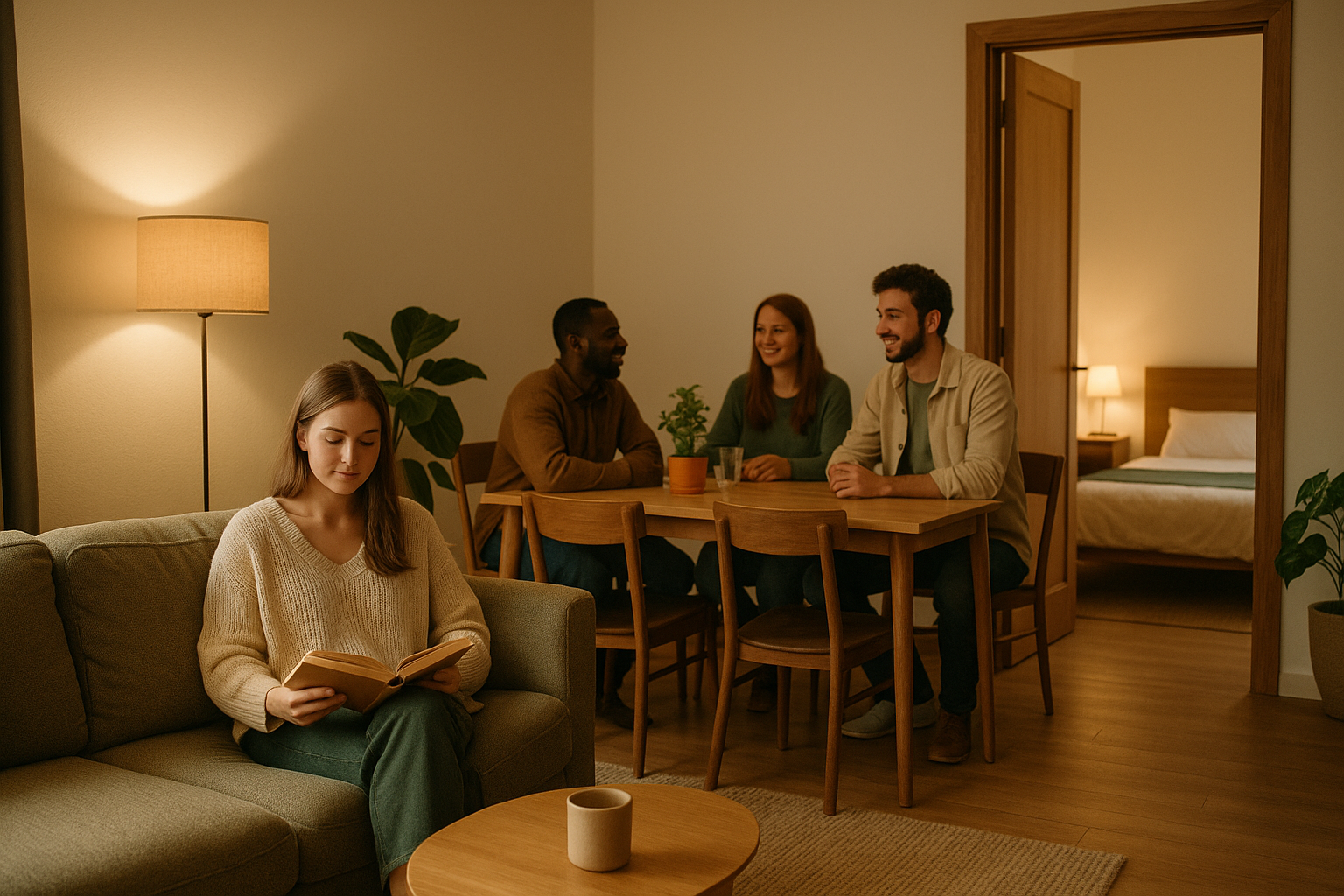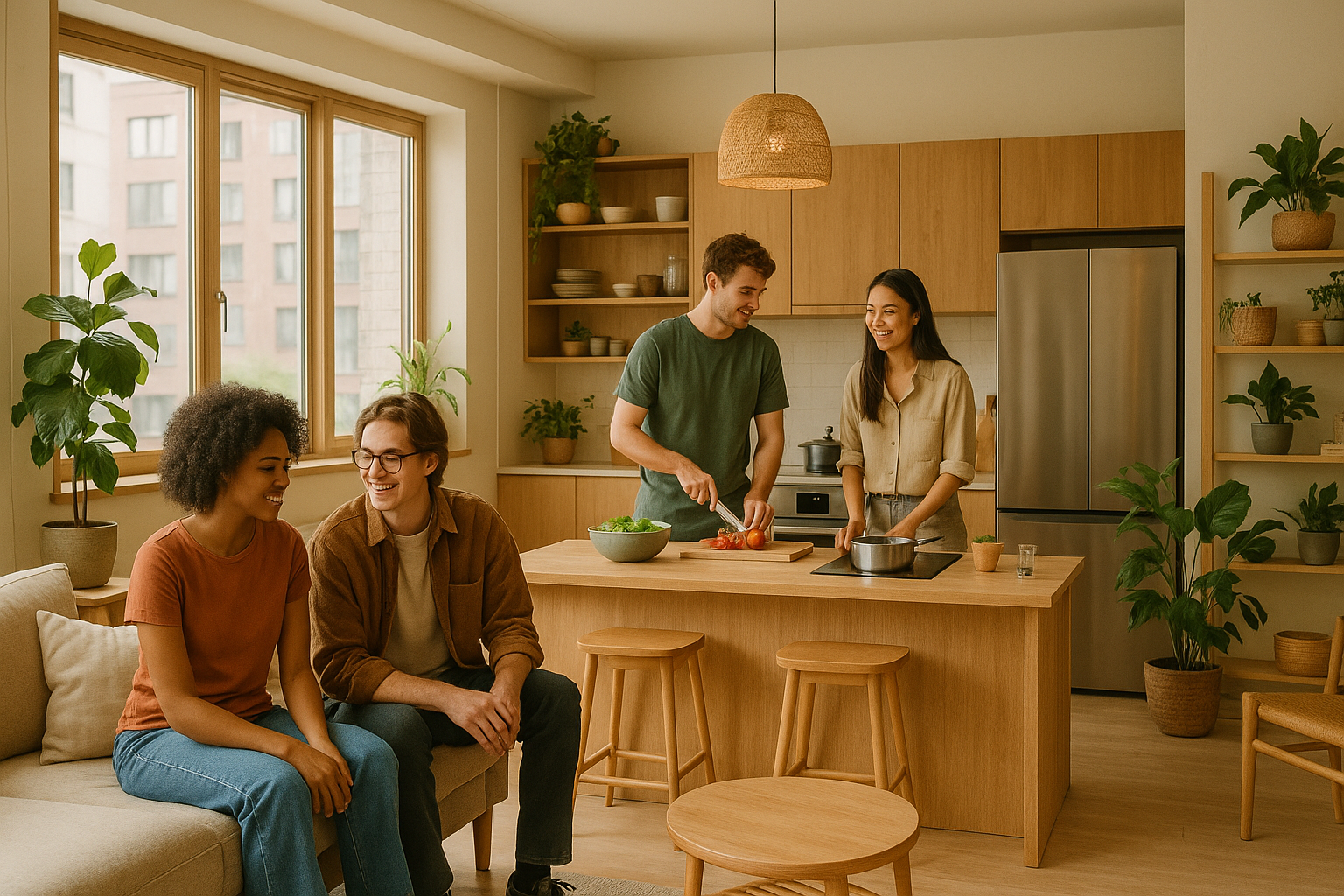Shared living spaces are becoming a popular housing choice, especially in cities. They combine private bedrooms or units with shared common areas, offering a mix of personal space and community interaction. This setup is especially appealing to young professionals and remote workers, as it provides an affordable and flexible living solution.
Key Points:
- Privacy: Residents have private rooms or studios, with features like secure entry and quiet zones.
- Community: Shared spaces (kitchens, lounges) and organized events encourage social connections.
- Affordability: Coliving can save up to 40% compared to traditional apartments.
- Challenges: Noise and shared amenities require balance and clear house rules.
- Design & Tech: Thoughtful layouts and smart tech (like booking apps) help maintain privacy and harmony.
Quick Comparison:
| Aspect | Privacy Focus | Community Focus |
|---|---|---|
| Social Interaction | Minimal | Active, group-oriented |
| Personal Space | High | Shared spaces, less private |
| Cost | Higher | Lower with shared expenses |
| Noise Levels | Quiet | Can be noisier |
| Networking | Fewer opportunities | Greater opportunities |
Modern coliving spaces, available in 350+ cities globally, are designed to strike the perfect balance between privacy and community, making them an attractive option for today's renters.
Privacy and Community Basics
This section dives into how coliving spaces strike a balance between privacy and community, creating a unique living experience.
Privacy in Shared Spaces
Coliving spaces are designed to offer both private and shared areas. Residents typically have private bedrooms or studio units, while shared amenities like kitchens and lounges encourage interaction. Features like secure entry systems and designated quiet zones help maintain personal space, ensuring everyone can enjoy solitude when needed.
Building Community
A strong sense of community is a key feature of coliving. Common areas, such as shared kitchens, workspaces, and lounges, naturally bring people together. These spaces make it easy for residents to connect and build relationships.
"The people are incredibly kind and the owner and staff do everything they can to make sure everyone feels a part of a special community. And I certainly felt that warmth - I made friends instantly and truly enjoyed every moment." - Angela G.
Organized activities also play a big role in strengthening community ties. Feedback from Coliving.com's network of over 100,000 members highlights the importance of features like:
| Community Feature | Purpose | Impact |
|---|---|---|
| Shared Workspaces | Professional networking | Encourages collaboration |
| Community Events | Social connection | Helps form lasting friendships |
| Common Areas | Casual interaction | Promotes spontaneous socializing |
| Rooftop Spaces | Relaxation & gatherings | Offers a neutral spot for bonding |
U.S. Living Preferences
In the U.S., coliving is becoming more popular, especially among young professionals and remote workers. These residents appreciate the mix of private spaces and vibrant communal areas that make socializing easy.
"The workspace and shared spaces were fantastic, including the rooftop, and my private area was just as impressive. The whole atmosphere made it easy to both work and relax, creating a perfect balance." - Tonette J.
Coliving is also cost-effective, often saving residents up to 40% compared to renting a traditional studio apartment. This affordability, combined with the balance of privacy and community, makes coliving an appealing choice.
Pros and Cons Analysis
Community Perks
Living in a community-centered environment can go beyond just sharing space - it can make life easier and more enjoyable. Shared utilities and services help cut down on living expenses, while amenities like high-speed Wi-Fi and housekeeping ensure a comfortable lifestyle without extra hassle.
On top of the practical benefits, the social aspect is a major draw. Being part of a network like Coliving.com, which connects over 100,000 members, allows residents to build meaningful relationships. These connections often go beyond surface-level friendships, creating a sense of belonging. Regularly organized activities further strengthen these bonds, making it easier to meet and interact with others.
"Sharing with others helps you find meaning, belonging and acceptance in life." - Coliving.com
Challenges with Privacy
Despite its benefits, community living does come with its own set of challenges, particularly when it comes to privacy. Noise is one of the most common issues in shared spaces, especially in communal areas or during events. For some, quiet time might require solutions like earplugs to block out distractions.
Another challenge is maintaining personal space. Shared amenities, such as kitchens or bathrooms, mean residents need to strike a balance between enjoying communal living and carving out moments of privacy. These challenges highlight the trade-offs involved and set the stage for a closer comparison.
Side-by-Side Comparison
| Aspect | Prioritizing Privacy | Prioritizing Community |
|---|---|---|
| Social Interaction | Minimal, more individual time | Active, group-oriented |
| Personal Space | Ample personal space | Shared spaces, less private |
| Cost Efficiency | Higher costs for private perks | Lower costs with shared expenses |
| Noise Levels | Quiet and controlled | Can be noisier |
| Networking | Fewer opportunities | Greater opportunities |
The success of coliving often depends on finding the right balance between privacy and community. While some residents value solitude, others thrive in a lively, shared environment. Many modern coliving spaces, spanning over 350 cities globally, now cater to both preferences by offering private areas alongside vibrant communal spaces. This balance is key to creating a harmonious living experience.
Balance Methods
Space Design Solutions
Modern coliving spaces are thoughtfully designed to balance private and communal living. Sound-dampening materials in walls and floors help keep noise levels low between rooms. Common areas, like kitchens and lounges, are placed away from private spaces, creating a natural separation. Many layouts include private bathrooms connected to individual rooms, giving residents their own personal retreat. The "buffer zone" approach ensures high-traffic areas are strategically positioned to reduce disruptions, offering a smooth transition between social and private zones. These design choices lay the groundwork for rules that further support this balance.
House Rules
House rules are key to maintaining harmony between personal privacy and community life. Common guidelines often include quiet hours and structured times for shared space usage. Here's an example of how these rules might look:
| Time Period | Noise Level | Common Area Usage |
|---|---|---|
| 7 AM – 9 AM | Moderate | Breakfast & morning routines |
| 9 AM – 6 PM | Normal | Work & social activities |
| 6 PM – 10 PM | Active | Community events & dining |
| 10 PM – 7 AM | Quiet | Essential use only |
Community agreements also address guest policies, shared amenity usage, and cleaning schedules. These rules not only protect individual privacy but also encourage positive interactions among residents. Technology further supports these efforts.
Privacy Tech
Digital tools play a growing role in managing shared living spaces. Smart access systems ensure private areas stay secure, while apps streamline the use of shared amenities. Many coliving spaces now rely on mobile platforms for tasks like:
- Scheduling shared facilities
- Managing package deliveries
- Arranging maintenance visits
- Connecting with neighbors
For example, automated booking systems help avoid double-booking shared spaces, making it easier to enjoy uninterrupted virtual meetings or personal downtime. These tech solutions enhance privacy while keeping the community running smoothly.
Bottom line...
Coliving thrives on a mix of smart design, clear guidelines, and integrated technology. These elements are what make shared living work for remote workers, students, and young professionals, offering a balance of personal space and social interaction.
Key Takeaways
A well-thought-out coliving setup uses design to create natural boundaries, minimizes noise, and promotes meaningful interactions. At the same time, clear rules and tech solutions ensure smooth day-to-day living.
Here’s a breakdown of the core elements:
| Element | Purpose | Impact |
|---|---|---|
| Physical Design | Establishes privacy zones | Reduces noise and conflict |
| Community Rules | Sets expectations | Promotes respectful coexistence |
| Tech Integration | Simplifies resource management | Enhances communication |
These principles not only define how coliving works today but also point to its future. With tools like smart access systems, booking platforms, and communication apps, residents can enjoy privacy while staying connected to their community.
"Sharing with others helps you find meaning, belonging and acceptance in life." - Coliving.com
FAQs
How do coliving spaces balance privacy with building a sense of community?
Coliving spaces strike a balance between privacy and community by offering private rooms for personal space alongside shared common areas like kitchens, lounges, and workspaces. This setup allows residents to connect with others when they choose, while still having a retreat for personal time.
To foster a sense of community, many coliving spaces organize social events, workshops, or group activities, creating opportunities for meaningful interactions. At the same time, these environments are designed to respect individual needs, ensuring spaces are comfortable for both relaxation and productivity.
What are some common challenges in coliving spaces, and how can they be addressed?
Shared living environments often come with challenges like noise from nearby traffic or busy communal areas, as well as balancing personal privacy with social interaction. To address noise, consider using earplugs, noise-canceling headphones, or scheduling work hours during quieter times.
Another common concern is maintaining a sense of community and comfort. Friendly and proactive hosts or staff play a key role in creating a welcoming atmosphere. Open communication with housemates and participating in community activities can also help foster positive relationships while respecting personal boundaries.
How does technology improve the coliving experience?
Technology plays a key role in enhancing the coliving experience by making daily life more convenient and connected. Features like high-speed Wi-Fi allow residents to seamlessly work remotely, stream entertainment, or stay connected with loved ones from anywhere within the shared space.
Additionally, many coliving spaces integrate smart systems for managing utilities, security, and bookings, creating a more efficient and hassle-free living environment. These tech-driven solutions help foster both productivity and a sense of community among residents.
























